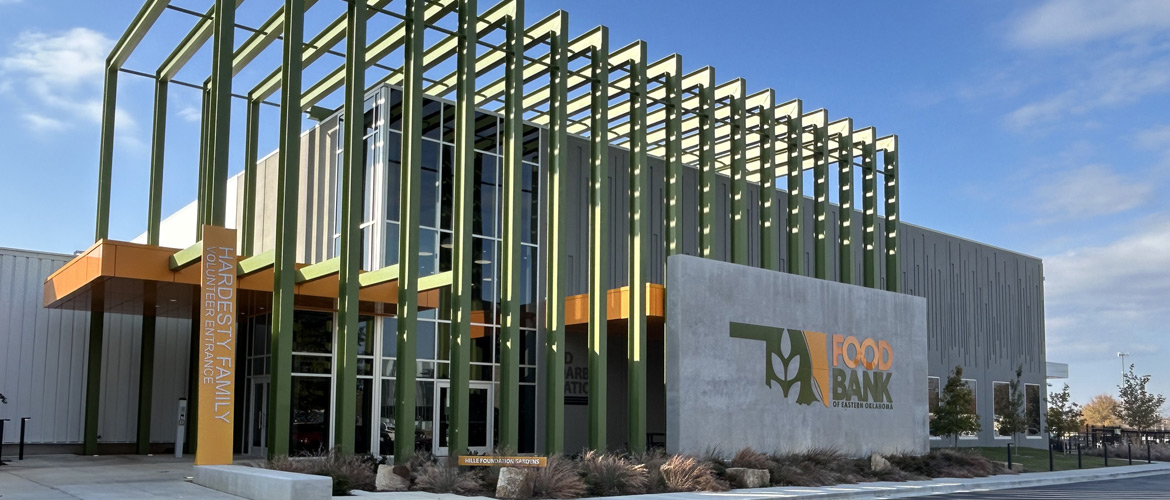Frozen meals delivered to the food pantry at Daniel Webster Middle and High School in Tulsa have helped hundreds of students in need of food for themselves and their families.
The microwaveable meals, cooked, frozen and delivered to the school by the Food Bank of Eastern Oklahoma in Tulsa, are sent home weekly with students whose families are food insecure. The program helps a spectrum of students — those feeding younger siblings or their own children, as well as those working to support their families, says Sharrice Banks, the school’s social services specialist.
“It’s a pretty broad group of students who need these meals,” says Banks, including one who relies on them to help feed 11 people at home. “Some of the stories I’ve heard are heartbreaking. Personally, these meals ease my mind because I know the students are eating.”
That wasn’t always the case before the food bank developed the frozen meal program.
For years, students using the school pantry took home some bulky and heavy items like frozen meats and canned goods. They didn’t eat the food because they didn’t have utilities, appliances or cookware to prepare it. Others didn’t know how to create meals out of what they took home.
“Some of these students have huge responsibilities at home,” Banks says. “Now, they don’t have to ask themselves, ‘What are we going to eat?’”
Launched in 2023, the food bank’s frozen meal program includes 10 school and campus pantries and supports about 150 students and their families who are food insecure. An estimated 17,000 meals are to be delivered this school year.
“Our mission is to provide people with delicious, nutritious and convenient meals with dignity,” says Homar Vicencio, project specialist at the food bank. “This program has helped middle and high school students, as well as nontraditional college students who are single parents feed and enjoy meals with their families.”
The program is among the first of its kind in a network of more than 200 food banks that partner with the national hunger-relief organization Feeding America®. Last year, Blue Cross and Blue Shield of Oklahoma awarded Food Bank of Eastern Oklahoma a $55,000 Blue Impact℠ grant to help fund the program and its expansion to 45 schools to deliver nearly 100,000 meals over three years.
“We have been able to share great information about the work that’s being done at the Food Bank of Eastern Oklahoma,” says Brooke Townsend, BCBSOK Community Affairs Director. “The frozen meal program is of interest even beyond our state, and we have great hope that it will be replicated.”
With the Blue Impact grant program, BCBSOK awarded 22 Oklahoma nonprofits more than $993,000 in 2024. The program invests in organizations working to address social and economic drivers of health, including nutrition.
Statewide, 1 in 4 children are food insecure, and more than half of Oklahoma’s students qualify for free or reduced meals, according to the food bank. The frozen food program is one of several initiatives the food bank has created to serve families in 24 counties since 1981.
In a nearly 13,000 square-foot production kitchen, Jeremy Johnson, the food bank’s chief culinary officer, leads a team of employees and volunteers as they prepare, cook, seal, label, box and freeze 10 menu items delivered to the pantry sites. Johnson understands the value of the program because there was a time when he probably could have benefited from it.
“A lot of our clients are short on time and resources,” says Johnson, whose office faces Carver Middle School. “I grew up right across the street. It reminds me of why I’m here and what it is I’m doing.”
Kathryn Strickland, Feeding America’s Chief Network Officer, believes the frozen meal program could be replicated at other food banks with commercial kitchens. She travels the country to see how food banks like the Food Bank of Eastern Oklahoma work with their community partners, including BCBSOK, to develop innovative programs to reduce food insecurity in dignified ways.
“A unique role of Feeding America is to bring colleagues, food bankers from all across the country together so that they can share ideas and innovate and troubleshoot and talk openly about challenges that they're having and collaborate on those solutions,” Strickland says.
The organizations strive to create programs that give everyone dignified access to healthy food choices, she says. “This is what we want for our communities — for communities to thrive together.”
Offering a resource to students in need
The families of most Webster students are economically disadvantaged. More than three-quarters of the school population qualify for reduced and free meals.
Despite the need, some students are reluctant to ask for help, Banks says. She recalls inviting a 17-year-old senior to use the pantry to help feed her younger siblings and family. She works to support them.
“Her paycheck could not stretch far enough to buy food,” Banks says. “She was trying her best. I knew she needed help, but she was resistant to use the pantry.”
Eventually, the student became more receptive to accepting help.
“That’s what it’s like every day,” Banks says. “We’re just letting students know the pantry is here for them.”

